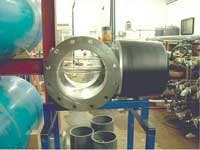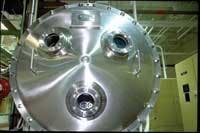Many water utilities across the United States have already revised their disinfection strategies to comply with increasingly stringent regulations for microbial contaminants and disinfection byproducts (DBPs). Others are reconsidering their strategies in an effort to achieve enhanced disinfection of microbial agents or to reduce the formation of DBPs in anticipation of the upcoming Long Term Stage 2 Enhanced Surface Water Treatment Rule and the Stage 2 Disinfectant/Disinfection Byproducts Rule. As often happens, questioning the traditional approach and exploring possible solutions have generated more questions than answers.
The water industry recognizes the potential benefits of replacing chlorine with an alternate disinfectant or combination of disinfectants to achieve increased disinfection effectiveness while limiting the formation of DBPs. Chloramines, chlorine dioxide, ozone, ultraviolet (UV) light, and booster chlorination are commonly considered alternatives to chlorine disinfection, alone or in combination. Less understood and more widely questioned is how changes in disinfection affect distribution system water quality in the long term.
To answer that particular question, the Awwa Research Foundation (AwwaRF) sponsored Project No. 2940: Long-term Effects of Disinfection Changes on Distribution System Water Quality. The Black & Veatch-led team also includes professionals from HDR/EES and McGuire Malcolm Pirnie as well as Dr. Anne Camper of Montana State University, Dr. Phil Singer of the University of North Carolina, and independent consultants Dr. Robert Hoehn and Dr. Donald Gates.
The research project, launched in November 2003, entailed collection and analysis of available utility and other data related to switching disinfectants. The research, which focuses on the effects of swapping chlorine disinfection for chloramines, ozone, chlorine dioxide, or UV - or adding booster chlorination - will culminate in a report that will be available from AwwaRF in mid-2006. The report will provide information for utility practice in selecting effective disinfection strategies and diagnosing water quality problems that may be caused by disinfectant changes
Potential Impacts
A change in disinfection strategy can impact distribution system water quality in various ways. It can produce:
• Changes in microbial quality;
• Changes in chemical quality such as DBP species and concentrations;
• Changes in chemical quality such as corrosion, metal release, the formation of color-producing compounds, and altered particle characteristics; and/or
• Changes in aesthetic quality, especially tastes and odors.
The research team began with a literature search and background review of all available information on changing disinfectants and the resultant effects on distribution system water quality. The second step required preparation of issue papers on each class of system impacts. The issue papers address key factors affecting water quality changes, positive impacts on water quality, potential adverse impacts on water quality, and information gaps and data needed to fill those gaps. The issue papers can be found at www.awwarf.org.
Data Evaluation
To document available data regarding the impacts of changing disinfectants on water quality in the distribution system, the research team designed and sent a questionnaire to 26 utilities. Of these, 21 responded with data representing 23 water treatment facilities and water quality information was received from 17 of the utilities.
The team requested data on treatment plant size, source of supply, processes, raw and finished water quality, and distribution system water quality. The utilities were asked if they had observed any changes in water quality after they had changed their disinfection strategies. If they had observed a change, they were requested to provide data (if available) for any parameters that changed - one year of data prior to the change and two years of data after the change.
Most of the data were from utilities that had changed from chlorine to either chloramines or ozone as shown below:
Disinfectant Change No. of Utilities
Chlorine to chloramines 7
Chlorine to ozone 6
Chlorine to chlorine dioxide 2
Chlorine to UV 2
Addition of booster chlorination 2
Results Summary
In general, the data indicate the following positive changes in the distribution system water quality as a result of changing disinfectants:
• Better microbial quality - lower coliform levels and heterotrophic plate counts (HPC)
• Lower disinfection byproducts - reduced levels of trihalomethanes (THMs) and haloacetic acids (HAAs)
• Reduced numbers of customer complaints regarding red water or discolored water
• Reduced numbers of customer complaints regarding tastes and odors
For most of the utilities that provided data, disinfection changes did not cause a change in lead or copper levels. Only one of the participating utilities experienced an increase in lead levels. More detailed information about the changes that were reported in the various water quality categories is presented below.
Microbial Changes: Several of the participating utilities reported changing from using chlorine to using chloramines as a secondary disinfectant. None of these utilities reported an increase in coliform levels and most reported a drop in HPC levels. One utility reported average HPC levels before the conversion of 1,200 colony forming units per milliliter (cfu/ml) in the distribution system, dropping to 65 cfu/ml within two years after the conversion. Another utility reported the benefit of being able to carry a higher chloramine residual for a longer time in the distribution mains compared to the use of chlorine, which resulted in a loss of residual for an equivalent time period.
At one utility, the Center for Disease Control conducted a study of Legionella bacteria in 53 buildings throughout the distribution system before and after conversion to chloramines. Bulk water sampling was conducted at boilers and water heaters. With the use of chlorine, 70 percent of the building water systems were colonized on one or more occasions and 50 percent were colonized in all three rounds of testing. After the conversion to chloramines, less than 10 percent of the building water systems were colonized. With chlorine, the average water heater Legionella concentration was 271 cfu/ml, while after the conversion the average dropped to 10 cfu/ml.
One of the utilities that switched from chlorine to chlorine dioxide reported an increase in HPC levels with use of chlorine dioxide as both a primary and secondary disinfectant compared to the use of chlorine dioxide as a primary disinfectant with chlorine as a secondary disinfectant. HPC levels dropped significantly when the utility switched to using chlorine dioxide as a primary disinfectant and chloramines as a secondary disinfectant. The utility also noted a change in the type of bacteria, indicating that when a disinfectant change is made, both the number and types of bacteria can change.
DBP Changes: All of the participating utilities changed their disinfection strategies in order to meet higher standards for THMs and HAAs, and all reported lower levels after making disinfectant changes. One utility that switched from chlorine to chloramines reported that THM levels dropped from 80-100 ug/L using chlorine to 40-60 ug/L after switching to chloramines. This same utility reported that HAA levels had dropped from 40-60 ug/L to 20-40 ug/L. Another utility reported a similar drop in THM levels after switching to chloramines - from above 80 ug/L to below 60 ug/L. Still another utility reported a significant decrease in THM levels after converting to chloramines - a drop from 20-140 ug/L to 25-50 ug/L.
Several of the participating utilities converted from chlorine to ozone as a primary disinfectant. Comparison of ozonated water versus non-ozonated water for one utility resulted in reductions of 15-25 percent of THM levels and 35 percent of HAA levels. Another utility reported a 30-50 percent reduction in both THM and HAA levels after converting to ozone as well as a 50 percent reduction in total organic halides (TOX), which is a measure of potential byproduct formation.
One of the systems that had switched from chlorine to chlorine dioxide indicated a reduction in THM levels from up to 350 ug/L to 50-70 ug/L. HAA levels were reported to be between 10 and 15 ug/L.
Corrosion/Metal Release Changes: Data regarding corrosion and metal release were limited but typically included customer complaint information regarding discolored water. In most instances, discolored water is caused by the release of iron from the interior of the distribution mains. Therefore, a change in the number and nature of discolored water complaints can be an indicator of the impact of a disinfectant change on metal release. One utility that switched from chlorine to chloramines reported that complaints about rusty and red water had ceased to be a problem. Another utility that switched to chloramines also indicated a drop in discolored water complaints after the switch.
One utility that switched to ozone had conducted extensive pilot tests on ozonated versus chlorinated water to determine the effects on heavily tuberculated pipe. The utility found that the ozonated water resulted in more iron being released into the bulk water compared to the chlorinated water.
Aesthetic Changes: The most frequent change reported was a reduction in customer complaints regarding tastes and odors in the water. One utility that replaced chlorine with chloramines showed a drop in customer complaints from as many as 10 per month to less than two per month. The nature of the complaints also changed - from mostly chlorinous tastes and odors to a greater variety of descriptors. Monochloramines have a higher threshold odor concentration than chloramines, and variations in residual concentrations are less noticeable by customers. Another utility reported a more positive attitude among customers regarding overall taste of the water after switching to chloramines. Two utilities that had switched to ozone also reported a reduction in taste and odor complaints after changing disinfectants.
Conclusions
Changes in disinfection strategies can have both beneficial and potentially adverse impacts on water quality in the distribution system. Utilities should evaluate all potential impacts before making any changes. The results of this research are intended to assist utilities in evaluating a disinfection change and the potential impacts on water quality in the distribution system.
Evaluation of the research results to date indicates that utilities experienced more positive impacts than adverse impacts by switching disinfectants. The majority of the changes were implemented to comply with more stringent DBP regulations, and the results were successful. More information is needed about impacts on particle characteristics and metal release, formation of other DBPs, and the types of bacteria that may exist in the distribution system after changing disinfectants. WW
About the Authors:
John E. Dyksen, P.E., is the Americas East Region Water Practice Leader for B&V Water, the water business of Black & Veatch Corporation (Kansas City, MO). He is based in Oradell, NJ. Catherine Spencer, P.E., is a Project Engineer for Black & Veatch Corporation based in Maine. Djanette Khiari, Ph.D., is a Project Manager with the Awwa Research Foundation based in Denver, CO.






